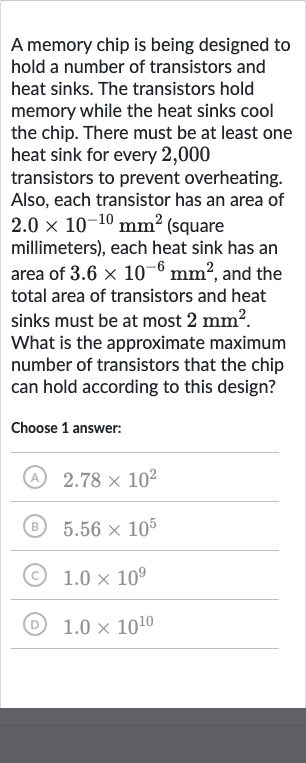AI tutor
Welcome to Bytelearn!
Let’s check out your problem:

A memory chip is being designed to hold a number of transistors and heat sinks. The transistors hold memory while the heat sinks cool the chip. There must be at least one heat sink for every , transistors to prevent overheating. Also, each transistor has an area of (square millimeters), each heat sink has an area of , and the total area of transistors and heat sinks must be at most . What is the approximate maximum number of transistors that the chip can hold according to this design?Choose answer:(A) (B) (C) (D)
Full solution
Q. A memory chip is being designed to hold a number of transistors and heat sinks. The transistors hold memory while the heat sinks cool the chip. There must be at least one heat sink for every , transistors to prevent overheating. Also, each transistor has an area of (square millimeters), each heat sink has an area of , and the total area of transistors and heat sinks must be at most . What is the approximate maximum number of transistors that the chip can hold according to this design?Choose answer:(A) (B) (C) (D)
- Determine Relationship: Determine the relationship between the number of transistors and heat sinks.According to the problem, there must be at least one heat sink for every transistors. This means that for every heat sink, there can be up to transistors.
- Calculate Area: Calculate the area occupied by one heat sink and , transistors. The area of one heat sink is given as . The area of one transistor is given as . Therefore, the area for , transistors is .
- Total Area Calculation: Calculate the total area for one heat sink and the corresponding , transistors.Total area for one set (one heat sink + , transistors) = Area of one heat sink + Area of , transistorsTotal area for one set = Total area for one set =
- Maximum Sets Calculation: Determine the maximum number of sets that can fit within the total area constraint of .
Total available area =
Area per set =
Maximum number of sets = Total available area / Area per set
Maximum number of sets =
Maximum number of sets = - Calculate Maximum Transistors: Calculate the maximum number of transistors by multiplying the number of sets by the number of transistors per set.Maximum number of transistors Maximum number of sets Number of transistors per setMaximum number of transistors sets transistors/setMaximum number of transistors transistors
More problems from Interpret parts of quadratic expressions: word problems
QuestionGet tutor help
QuestionGet tutor help
QuestionGet tutor help
QuestionGet tutor help
QuestionGet tutor help
QuestionGet tutor help
QuestionGet tutor help
QuestionGet tutor help
